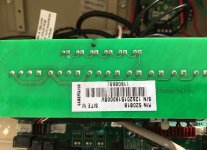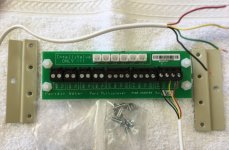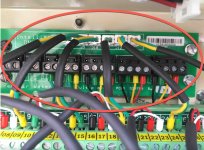Background: Recently, I installed a Pentair Serial COM Port Expansion Board (Port Multiplexer), in my IntelliCenter Load Center. I thought I might share some information regarding this expansion board and its installation.
The Pentair Serial COM port expansion board can be used with any Pentair IntelliCenter, IntelliTouch and EasyTouch Automation Control System. A total of two (2) Serial COM Port Expansion Boards can be installed.
There are two reasons that a Pentair Automation user may wish to install this board.
The part number for the Serial COM Port Expansion Kit is: 520818. The cost is approximately $60.00. I paid $57.90 on Amazon (no shipping or taxes).
The following items are included in the kit:
The three COM Ports share a common bus. Thus, the following type equipment/accessories can connect to any of these ports. This list is just an example and not all inclusive.
The two pin screw terminal blocks can be used for RS-485 or RS-232 communications for equipment such as:
Pentair IntelliFlo Pumps
Pentair UltraTemp and Hybrid Heat Pumps
INSTALLATION -
Note: The following is a detailed explanation of the installation (and any tips/tricks that I can think of) of the Serial COM Port Expansion Board in the Pentair IntelliCenter Load Center. Installing the expansion board in any other automation system may or may not be similar.
WARNING: ALWAYS remove power from the Load Center/Power Center and from any items that you are connecting before proceeding. De-energizing ALL applicable circuit breakers is the approved method of removing power from these items. Failure to do so may result in electrical shock and/or damage to equipment.
CAUTION: ALWAYS use approved anti-static precautions when handling circuit boards. Failure to do so may result in damage to equipment.
1. Remove the four adhesive backed supports using a 1/4" socket. (these are for use in older type load centers, that do not have the two applicable mounting screws for the expansion board).
2. Unlatch the front door spring latch to open the load center door.
3. Loosen the two access screws securing the IntelliCenter Control Panel using a 1/4" socket and fold it down.
4. Using a 1/4" socket, remove the two screws from the back of the load center upper low voltage compartment as illustrated below.
5. Install the two Expansion Board brackets and secure with the same two screws as illustrated below.
7. The Serial COM Port Expansion Board is shipped with the cable connectors plugged in to J2 and J3 of the expansion board. Remove the terminal connector J2 on the Expansion Board and connect it to a COM port on the IntelliCenter Control System Personality Board as depicted in the above illustrations.
8. If you have existing equipment and/or accessories (IntelliChlor, IntelliChem, IntelliFlo Pump, UltraTemp and Hybrid Heat Pumps, Remote Control Panels etc., connected to the IntelliCenter Automation System Mother Card remove the connector with attached wires and connect the connector to an available terminal on the Expansion board COM port (as shown above).
9. After the Expansion Board has been mounted and all equipment/accessories connected, close the control panel into its original position and secure it with the two access screws. Apply power to the system by energizing the applicable circuit breakers and close the load center front door. Fasten the spring latch.
Hope this helps with anyone installing the Pentair Serial COM Port Expansion Board in an IntelliCenter Load Center.
Please feel free to ping me if you have any questions...
r.


The Pentair Serial COM port expansion board can be used with any Pentair IntelliCenter, IntelliTouch and EasyTouch Automation Control System. A total of two (2) Serial COM Port Expansion Boards can be installed.
There are two reasons that a Pentair Automation user may wish to install this board.
1. An IntelliCenter user who may be interested in taking advantage of the full RS-485 capability of their IntelliValve(s) once the anticipated Pentair IntelliCenter over-the-air (OTA) update is released, that will allow for that functionality and/or,
2. An IntelliCenter/IntelliTouch/EasyTouch user that wants more RS-485 /Serial COM port connectivity AND chooses not to "pigtail" those connections in the limited Serial COM port connectors located on the control system main boards (typically only two (2)).
The part number for the Serial COM Port Expansion Kit is: 520818. The cost is approximately $60.00. I paid $57.90 on Amazon (no shipping or taxes).
The following items are included in the kit:
1. One Serial COM Port Expansion Board populated with:
- Three (3) four position screw terminal blocks (COM Ports) J1-J3
- Four (4) two position screw terminal blocks (Serial Ports) J4-J7
- Six (6) IntelliValve two pin connectors (these are for the yellow and green wires connected to the IntelliValve valve actuator). J8-J13.
2. 12" long, four-conductor cable attached to two four-position terminal blocks (this wire connects one of the 4 pin screw connectors on the control system main board).
3. Four-screws, two Expansion Board brackets and the Installation Guide.
Any Pentair equipment/accessory that connects to four pin screw terminal blocks can be connected to the three four pin screw terminal blocks on the expansion board.
NOTE: One COM port terminal block is used to connect to the control system main board.The three COM Ports share a common bus. Thus, the following type equipment/accessories can connect to any of these ports. This list is just an example and not all inclusive.
Pentair Remote Controllers to include wireless controllers
Indoor Remote Controllers
i5x and i10x Expansion Load Centers
ScreenLogic® Interface Protocol Adapter,
IntelliChlor Chlorine Generator
i-Link™ Protocol Interface adapter
IntelliChem (NOTE: IntelliChem connections do not use the RED connection). Only the yellow, Green and Black)
Spa-Side Remotes
The two pin screw terminal blocks can be used for RS-485 or RS-232 communications for equipment such as:
Pentair IntelliFlo Pumps
Pentair UltraTemp and Hybrid Heat Pumps
INSTALLATION -
Note: The following is a detailed explanation of the installation (and any tips/tricks that I can think of) of the Serial COM Port Expansion Board in the Pentair IntelliCenter Load Center. Installing the expansion board in any other automation system may or may not be similar.
WARNING: ALWAYS remove power from the Load Center/Power Center and from any items that you are connecting before proceeding. De-energizing ALL applicable circuit breakers is the approved method of removing power from these items. Failure to do so may result in electrical shock and/or damage to equipment.
CAUTION: ALWAYS use approved anti-static precautions when handling circuit boards. Failure to do so may result in damage to equipment.
1. Remove the four adhesive backed supports using a 1/4" socket. (these are for use in older type load centers, that do not have the two applicable mounting screws for the expansion board).
2. Unlatch the front door spring latch to open the load center door.
3. Loosen the two access screws securing the IntelliCenter Control Panel using a 1/4" socket and fold it down.
4. Using a 1/4" socket, remove the two screws from the back of the load center upper low voltage compartment as illustrated below.
5. Install the two Expansion Board brackets and secure with the same two screws as illustrated below.
Note: Do not tighten yet. Leave these two screws slightly loose until after mounting the expansion board to the brackets.
6. Mount the Expansion Board onto the bracket and secure with the four screws that are provided in the kit using a 1/4" socket as illustrated below. Then tighten the two screws that mount the brackets.7. The Serial COM Port Expansion Board is shipped with the cable connectors plugged in to J2 and J3 of the expansion board. Remove the terminal connector J2 on the Expansion Board and connect it to a COM port on the IntelliCenter Control System Personality Board as depicted in the above illustrations.
8. If you have existing equipment and/or accessories (IntelliChlor, IntelliChem, IntelliFlo Pump, UltraTemp and Hybrid Heat Pumps, Remote Control Panels etc., connected to the IntelliCenter Automation System Mother Card remove the connector with attached wires and connect the connector to an available terminal on the Expansion board COM port (as shown above).
9. After the Expansion Board has been mounted and all equipment/accessories connected, close the control panel into its original position and secure it with the two access screws. Apply power to the system by energizing the applicable circuit breakers and close the load center front door. Fasten the spring latch.
Hope this helps with anyone installing the Pentair Serial COM Port Expansion Board in an IntelliCenter Load Center.
Please feel free to ping me if you have any questions...
r.


Last edited:




